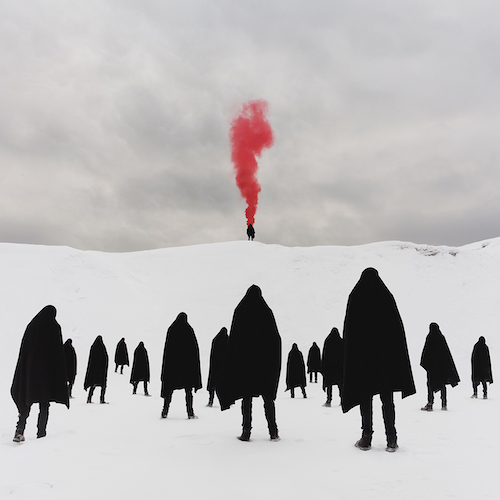 'Sigil' by Sean Mundy (reproduced with artist permission).
'Sigil' by Sean Mundy (reproduced with artist permission).
Photo LA 2019
Photo LA in Santa Monica was a storm of over 60 contemporary photography galleries from all corners of the Earth. It provided more validation of Los Angeles as a locus for contemporary fine art and great representations of experimental artwork. My favorites from the show:
Sean Mundy’s Sigil, found in the Gallerie Youn booth among at least a dozen other works, imbues a sense of harrow upon instant perception. We cannot but help to be drawn into this enigmatic ominousness, as if we are privately watching a cultic ritual take place in a dystopian future ice age. It does provide a sense of violent premonition, as if this tribe, which we are coerced by the photographer to participate with, is about to battle what lies over the horizon. And what a horizon this is! As with all fine art, to be able to be absorbed by the frost-bitten landscape in person provides the excellent use of natural pigmentation captured by the camera lens. The pure crispness of the snow white emphasizes the black marauders being called to arms with the blood red signal.
Yet why must this work be interpreted so dramatically? Why can’t this band of people be entertaining themselves versus attempting to overcome an existential threat that lurks beyond? Perhaps the harshness of the wilderness provides us with a sense of querulous drama, and the unfriendly capes beckon us to imagine battle drums to permeate the icy air. This is no paradise being captured, this is a raw and perhaps barbaric pilgrimage that is taking place. And yet it still is beautiful to behold!
A striking reflection on the nature of our world; how a violent narrative can be made vividly brilliant. It allows us to pontificate, then, on the bigger picture than the impending bloodstains on the pure snow. That, even amidst the turmoil of the human life and its melodrama, it is ensconced in natural beauty. Further, the turmoil itself is a manifestation of the same causality which gives us such incomprehensible flavors to our eyesight.
Mr. Mundy, then, is giving us a diorama to dialectically present the struggle with the human condition being apart of a cosmic storyline, where we must expect the ending to be a happily ever after one. For this tribe is acting in accord with its designs and out of this will breed civilizing powers which will no longer find violent action as necessary. This is not an opinion, but a resonating fact with the historical conditions of the European barbarian, who over eons vanquished the environment and themselves to find equilibrium, harmony, with the world and providing the pacifying force of Christendom from sunrise to sunset across the Earth. A religion, mind you, which voluntarily abandoned slavery practices and has provided the world the template for wealth creation with its morality in the markets.
So, there is a larger story being played, regardless of how fatalistic the world may appear. Dystopia, we must affirm, will change into utopia – perhaps by the one creating the sigil? Hope, Mr. Mundy perceives, is a rejuvenating power in the human condition.
Polly Borland’s Morph Seriespresented at the fair by Nino Mier Gallery was an extremely daring yet brilliantly successful experiment in photography collection of eight or so works that were displayed. I can’t quite put words on what these figures are; amorphousdoesn’t do their contortions justice; nor can I quite grasp the inconceivably resolute paleness which acts so magnificently as a contrast to the background hues. This is dream-weaving at its finest, and is reminiscent of the Hubble Telescopic photography of celestial births.
These objects do appear to be human in some erratic form, as if they were compacted like a bonzai tree for many years to take their shape. But it is this form, nevertheless, which is breathtaking to behold in its novel assemblies. The geometry is sensually voluptuous, with boundless curvatures which provide a sense of bounty and ripeness to each plump rise and fall. Yet the color palette is not meant to scintillate and leave our mouths watery. This work is far too high-minded for such feral lust.
There is a sense of placidness to each work, that these forms are motionless despite their unwavering shapes. They are not radical; not violent in their attention-seeking. They draw us in calmly, peacefully, to experience what all art ought to: deliver us the inconceivable.
But we must return to the anthropic shapes which are hidden now and then while leaving our humanity out of the diagnosis. Instead, we ought to perceive this amalgam as a strenuous effort at expanding natural beauty and its cosmogony, which after all includes human flesh and its designs. Ms. Borland’s works are an extension, then, of nature’s ripeness in creation.

